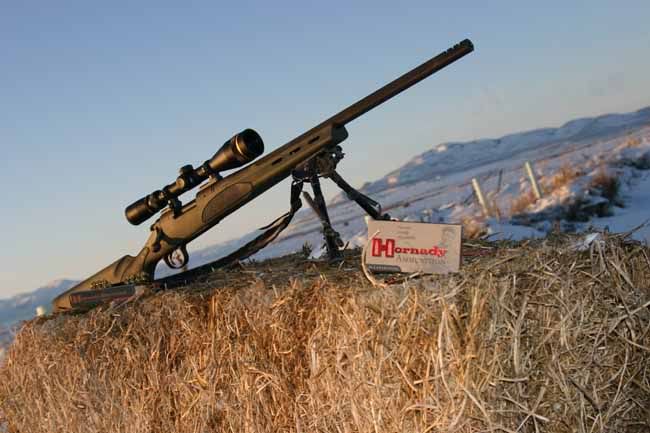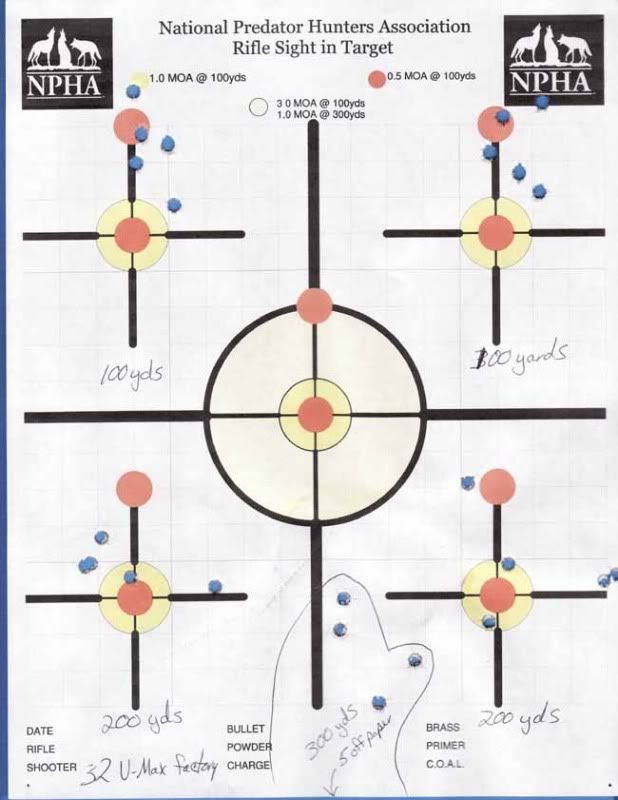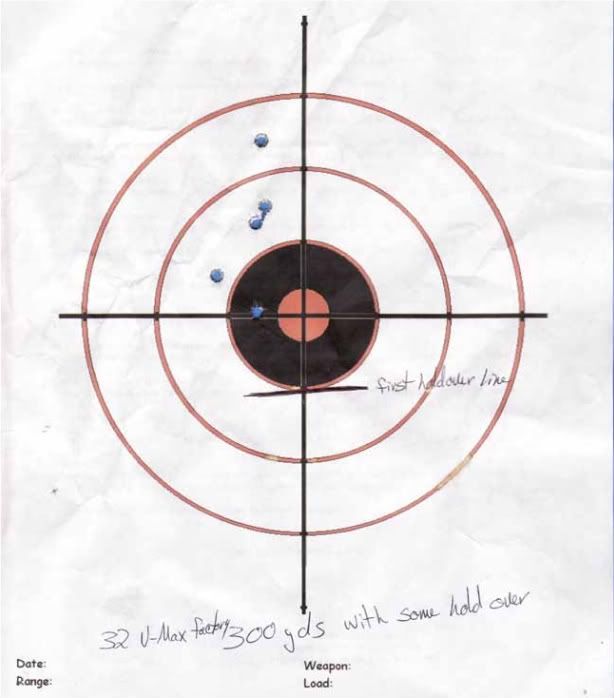Remington 700 VTR Review
Posted: Fri Mar 04, 2011 9:36 pm
If you don't want to read this windy description skip down to the second post for a range report.
Why .204 Ruger
While out calling coyotes I had night mares about a $400 bobcat stepping out of cover and the 22-250 Rem. I was holding reducing the bobcat to $25. (At least that is how I pitched it to my wife.) I had already witness first hand the effectiveness of 35 grain Burgers on coyotes and bobcats at velocities around 4000 f.p.s.. I like to have the option of buying ammunition off the shelf in a pinch. It has been several years now and factory loaded .204 Ruger ammunition seems readily available now.
Why the Remington 700 VTR
The primary purpose of this rifle was to take calling predators. For me that means that it must point and swing well. It can’t be so pretty that I worry about dinging the stock, or scratching the finish. I do not want to risk a bright shiny barrel that might flash when making minor - deliberate adjustments while the coyote is coming in drawing attention to me. I also like the feel of varmint/target barrel and stock configurations.
As I visited various manufactures websites I came across many rifles that I would love to have, but would hate to take coyote hunting. I knew these rifles would wait in the cabinet to be put in a hard case and transported to the range, or the lava flows. Something that doesn’t happen much anymore.
100% of the shopping for this rifle was done on the internet. I purposely avoided the message boards for this purchase. I find it is difficult to tell if there are multiple people parroting the same isolated problem. I did look at other manufactures but there was always something that I was unfamiliar with or unsure about. Without the benefit of fondling the rifle I found myself gravitating to models and manufactures that I was familiar with. My Remington 700 BDL in 22-250 with 22” barrel has served me well for many years and influenced my choice in a big way. I also enjoy thumbing my nose at the liberal media every chance I get.

Initial impressions.
This is the first rifle I have purchased without first fondling it in a store. I was a little nervous what it would be like once it got here. When I took it out of the box the first thing I did was put it to my shoulder. The 22 inch barrel makes for quick pointing and an easy comfortable swing. That will due for those times that I wish I had brought the shotgun.
The stock is made of a green composite, with black over molds rather than customary checkering. The vented forearm is 2” wide with two lugs to accommodate a bipod and a sling. Finished off with a low profile cheek rest. It is comfortable for me to hold. I do wonder what the materials used will do in summer heat, but this is a coyote rig so I may never know.
When I buy a rifle with a varmint tag on it I expect a minimum of 3 easily verified characteristics: 1) a fat barrel. 2) a wide fore-end so the rifle will sit firmly in a sand bag. 3) a full floated barrel from the action forward. I guess 2 out of three isn’t bad. On this particular rifle I can not get a dollar bill started between the barrel and stock, let alone slide it to the action. I’m thinking that I will give it a fair chance before I “fix” anything. If I get this barrel hot the coyote deserves to play another day anyway. I’m sure ambient temperature could cause some issues, the severity of those will be the determining factor of “fixing” it or not.
The trigger, a little heavy for my personal preference, feels clean and crisp with no creep or over travel. It breaks at 3 ¾ #.
The elephant in the room is the triangular barrel with a muzzle break. The un-customary shaped barrel gives the VTR a look of it’s own. I did kind of wonder about the shape of the barrel and it’s usefulness. Cooling time and strength can be debated but I know I got a heavy barrel feel without as much weight. The muzzle brake uses up the last 1 ¾ inches of the barrel.

I outfitted my VTR with a Leupold VX-3 4.5-14X40 with an adjustable objective, and a varmint hunters reticle. Leupold bases and rings as well.

Why .204 Ruger
While out calling coyotes I had night mares about a $400 bobcat stepping out of cover and the 22-250 Rem. I was holding reducing the bobcat to $25. (At least that is how I pitched it to my wife.) I had already witness first hand the effectiveness of 35 grain Burgers on coyotes and bobcats at velocities around 4000 f.p.s.. I like to have the option of buying ammunition off the shelf in a pinch. It has been several years now and factory loaded .204 Ruger ammunition seems readily available now.
Why the Remington 700 VTR
The primary purpose of this rifle was to take calling predators. For me that means that it must point and swing well. It can’t be so pretty that I worry about dinging the stock, or scratching the finish. I do not want to risk a bright shiny barrel that might flash when making minor - deliberate adjustments while the coyote is coming in drawing attention to me. I also like the feel of varmint/target barrel and stock configurations.
As I visited various manufactures websites I came across many rifles that I would love to have, but would hate to take coyote hunting. I knew these rifles would wait in the cabinet to be put in a hard case and transported to the range, or the lava flows. Something that doesn’t happen much anymore.
100% of the shopping for this rifle was done on the internet. I purposely avoided the message boards for this purchase. I find it is difficult to tell if there are multiple people parroting the same isolated problem. I did look at other manufactures but there was always something that I was unfamiliar with or unsure about. Without the benefit of fondling the rifle I found myself gravitating to models and manufactures that I was familiar with. My Remington 700 BDL in 22-250 with 22” barrel has served me well for many years and influenced my choice in a big way. I also enjoy thumbing my nose at the liberal media every chance I get.

Initial impressions.
This is the first rifle I have purchased without first fondling it in a store. I was a little nervous what it would be like once it got here. When I took it out of the box the first thing I did was put it to my shoulder. The 22 inch barrel makes for quick pointing and an easy comfortable swing. That will due for those times that I wish I had brought the shotgun.
The stock is made of a green composite, with black over molds rather than customary checkering. The vented forearm is 2” wide with two lugs to accommodate a bipod and a sling. Finished off with a low profile cheek rest. It is comfortable for me to hold. I do wonder what the materials used will do in summer heat, but this is a coyote rig so I may never know.
When I buy a rifle with a varmint tag on it I expect a minimum of 3 easily verified characteristics: 1) a fat barrel. 2) a wide fore-end so the rifle will sit firmly in a sand bag. 3) a full floated barrel from the action forward. I guess 2 out of three isn’t bad. On this particular rifle I can not get a dollar bill started between the barrel and stock, let alone slide it to the action. I’m thinking that I will give it a fair chance before I “fix” anything. If I get this barrel hot the coyote deserves to play another day anyway. I’m sure ambient temperature could cause some issues, the severity of those will be the determining factor of “fixing” it or not.
The trigger, a little heavy for my personal preference, feels clean and crisp with no creep or over travel. It breaks at 3 ¾ #.
The elephant in the room is the triangular barrel with a muzzle break. The un-customary shaped barrel gives the VTR a look of it’s own. I did kind of wonder about the shape of the barrel and it’s usefulness. Cooling time and strength can be debated but I know I got a heavy barrel feel without as much weight. The muzzle brake uses up the last 1 ¾ inches of the barrel.

I outfitted my VTR with a Leupold VX-3 4.5-14X40 with an adjustable objective, and a varmint hunters reticle. Leupold bases and rings as well.






